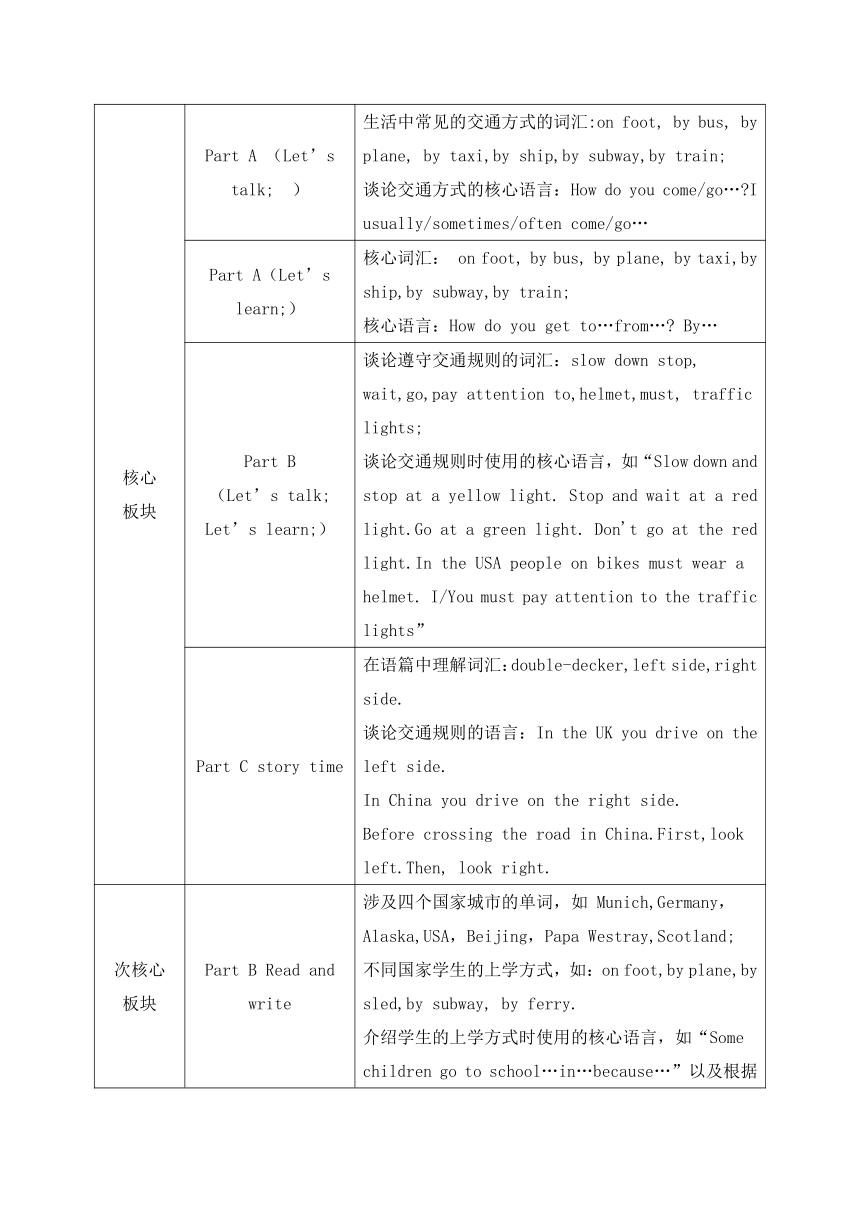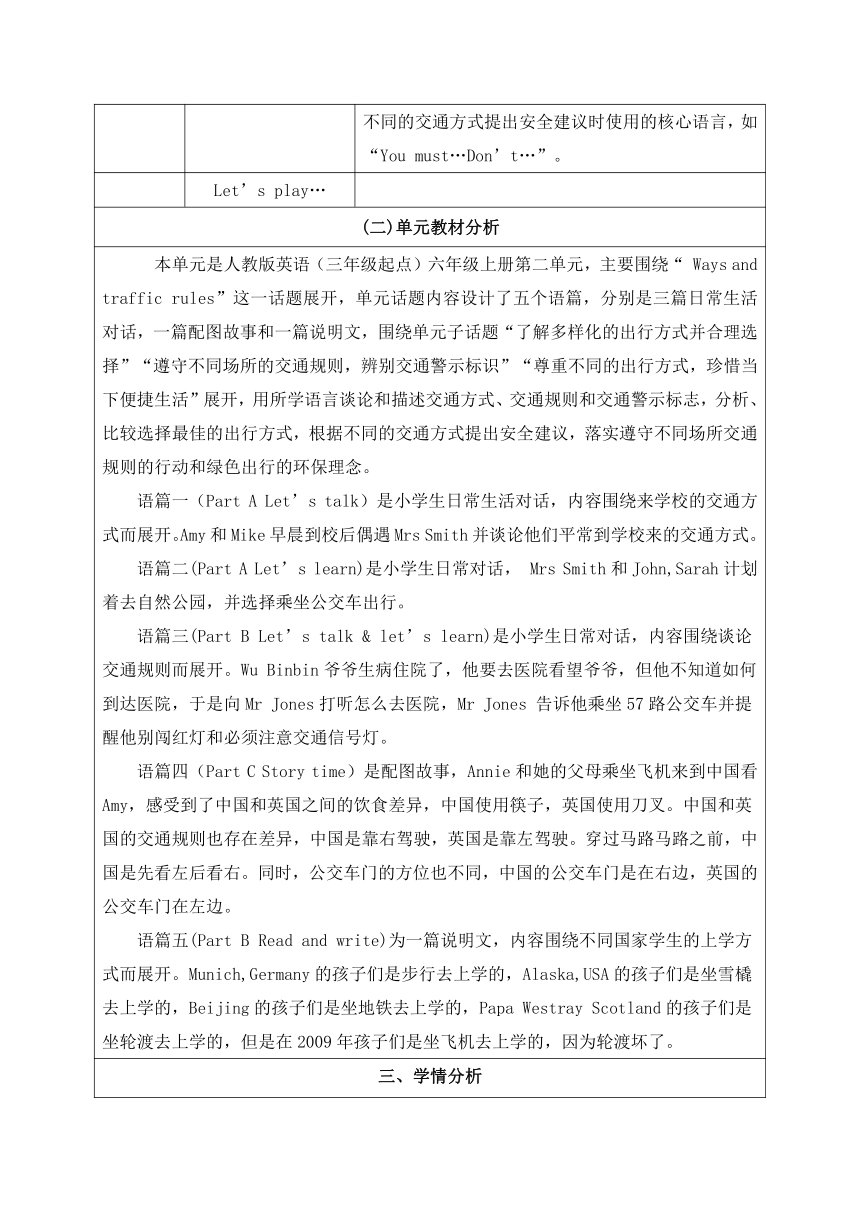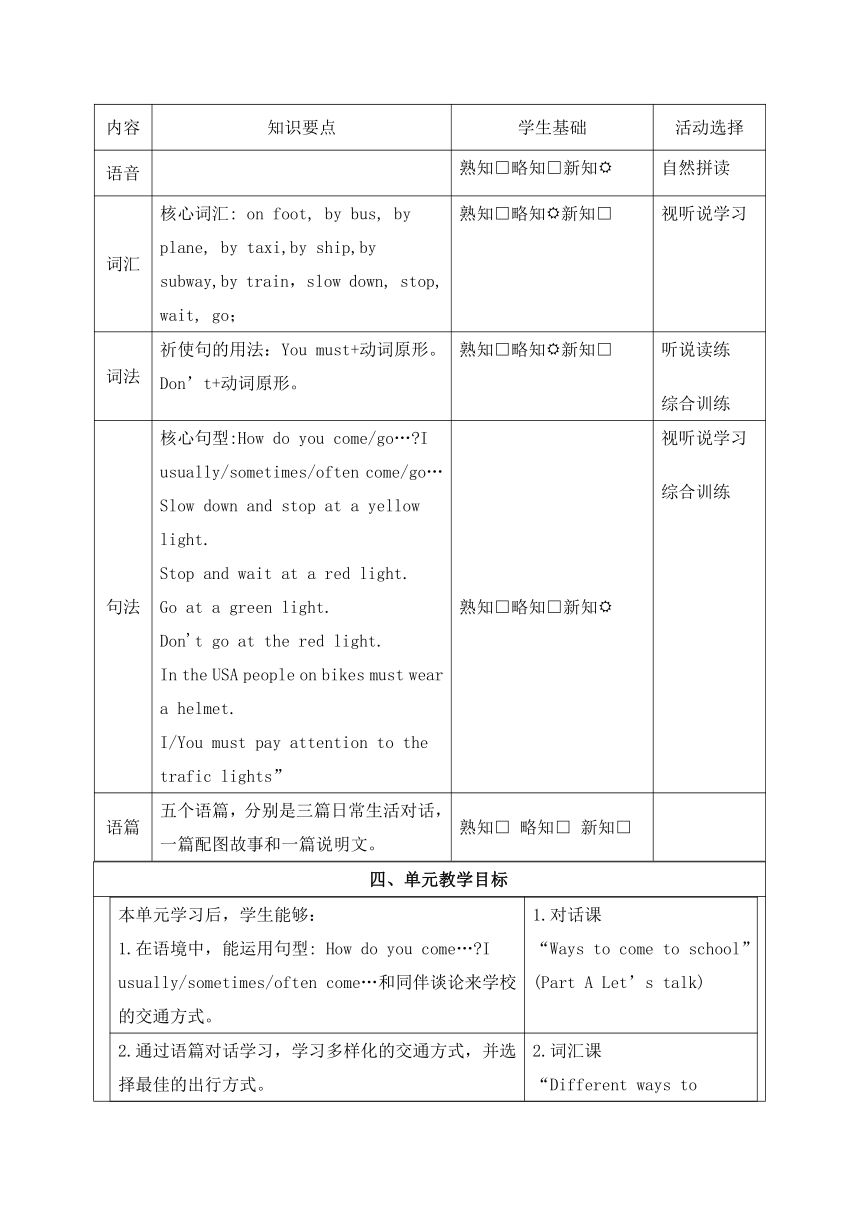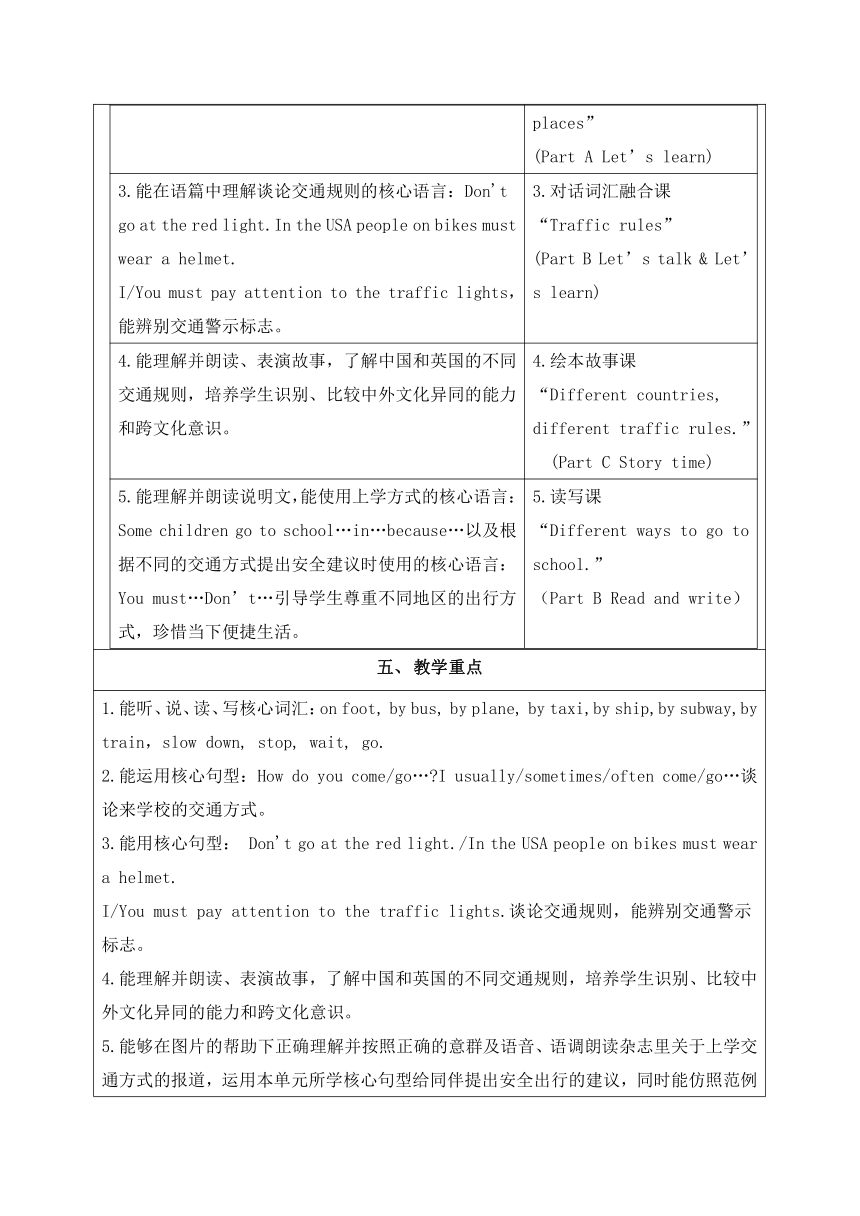Unit 2.Ways to go to school表格式教学设计(共6课时)
文档属性
| 名称 | Unit 2.Ways to go to school表格式教学设计(共6课时) |  | |
| 格式 | docx | ||
| 文件大小 | 474.3KB | ||
| 资源类型 | 教案 | ||
| 版本资源 | 人教版(PEP) | ||
| 科目 | 英语 | ||
| 更新时间 | 2024-10-04 18:16:57 | ||
图片预览





文档简介
六年级上册大单元备课电子教案
年级 六 学科 英语 主备教师
课题:人教版英语PEP六年级上册Unit 2.Ways to go to school
第一部分:单元规划
一、课标解读
《义务教育英语课程标准(2022年版)》指出:英语课程内容由主题、语篇、语言知识、文化知识、语言技能和学习策略等要素构成。围绕这些要素,通过学习理解、应用实践、迁移创新等活动,推动学生核心素养在义务教育全程中持续发展。课程内容的六个要素是一个相互关联的有机整体,共同构成核心素养发展的内容基础。其中,主题具有联结和统领其他内容要素的作用,为语言学习和课程育人提供语境范畴;语篇承载表达主题的语言知识和文化知识,为学生提供多样化的文体素材;语言知识为语篇的构成和意义的表达提供语言要素;文化知识为学生奠定人文底蕴、培养科学精神、形成良好品格和正确价值观提供内容资源。 单元整体教学是指教师基于课程标准,围绕特定主题,对教材等教学资源进行深入解读、分析、整合和重组后,搭建起的一个由单元大主题统领、各语篇次主题相互关联、逻辑清晰的完整教学单元,使教学能够围绕一个完整的主题设定单元目标,引导学生基于对单独语篇小观念的学习和提炼,逐步构建基于该单元主题的大观念。
二、教材分析
项目 人教版英语PEP六年级上册 Unit 1 Ways to go to school
主题范畴 √人与社会 人与自然 √人与自我
功能 √交往 √感情 √态度
主题意义 用所学语言谈论和描述交通方式、交通规则和交通警示标志,分析、比较选择最佳的出行方式,根据不同的交通方式提出安全建议,落实遵守不同场所交通规则的行动和绿色出行的环保理念。
(一)单元教材板块分析
主要内容
核心 板块 Part A (Let’s talk; ) 生活中常见的交通方式的词汇:on foot, by bus, by plane, by taxi,by ship,by subway,by train; 谈论交通方式的核心语言:How do you come/go… I usually/sometimes/often come/go…
Part A(Let’s learn;) 核心词汇: on foot, by bus, by plane, by taxi,by ship,by subway,by train; 核心语言:How do you get to…from… By…
Part B (Let’s talk; Let’s learn;) 谈论遵守交通规则的词汇:slow down stop, wait,go,pay attention to,helmet,must, traffic lights; 谈论交通规则时使用的核心语言,如“Slow down and stop at a yellow light. Stop and wait at a red light.Go at a green light. Don't go at the red light.In the USA people on bikes must wear a helmet. I/You must pay attention to the traffic lights”
Part C story time 在语篇中理解词汇:double-decker,left side,right side. 谈论交通规则的语言:In the UK you drive on the left side. In China you drive on the right side. Before crossing the road in China.First,look left.Then, look right.
次核心 板块 Part B Read and write 涉及四个国家城市的单词,如 Munich,Germany,Alaska,USA,Beijing,Papa Westray,Scotland; 不同国家学生的上学方式,如:on foot,by plane,by sled,by subway, by ferry. 介绍学生的上学方式时使用的核心语言,如“Some children go to school…in…because…”以及根据不同的交通方式提出安全建议时使用的核心语言,如“You must…Don’t…”。
Let’s play…
(二)单元教材分析
本单元是人教版英语(三年级起点)六年级上册第二单元,主要围绕“ Ways and traffic rules”这一话题展开,单元话题内容设计了五个语篇,分别是三篇日常生活对话,一篇配图故事和一篇说明文,围绕单元子话题“了解多样化的出行方式并合理选择”“遵守不同场所的交通规则,辨别交通警示标识”“尊重不同的出行方式,珍惜当下便捷生活”展开,用所学语言谈论和描述交通方式、交通规则和交通警示标志,分析、比较选择最佳的出行方式,根据不同的交通方式提出安全建议,落实遵守不同场所交通规则的行动和绿色出行的环保理念。 语篇一(Part A Let’s talk)是小学生日常生活对话,内容围绕来学校的交通方式而展开。Amy和Mike早晨到校后偶遇Mrs Smith并谈论他们平常到学校来的交通方式。 语篇二(Part A Let’s learn)是小学生日常对话, Mrs Smith和John,Sarah计划着去自然公园,并选择乘坐公交车出行。 语篇三(Part B Let’s talk & let’s learn)是小学生日常对话,内容围绕谈论交通规则而展开。Wu Binbin爷爷生病住院了,他要去医院看望爷爷,但他不知道如何到达医院,于是向Mr Jones打听怎么去医院,Mr Jones 告诉他乘坐57路公交车并提醒他别闯红灯和必须注意交通信号灯。 语篇四(Part C Story time)是配图故事,Annie和她的父母乘坐飞机来到中国看Amy,感受到了中国和英国之间的饮食差异,中国使用筷子,英国使用刀叉。中国和英国的交通规则也存在差异,中国是靠右驾驶,英国是靠左驾驶。穿过马路马路之前,中国是先看左后看右。同时,公交车门的方位也不同,中国的公交车门是在右边,英国的公交车门在左边。 语篇五(Part B Read and write)为一篇说明文,内容围绕不同国家学生的上学方式而展开。Munich,Germany的孩子们是步行去上学的,Alaska,USA的孩子们是坐雪橇去上学的,Beijing的孩子们是坐地铁去上学的,Papa Westray Scotland的孩子们是坐轮渡去上学的,但是在2009年孩子们是坐飞机去上学的,因为轮渡坏了。
三、学情分析
内容 知识要点 学生基础 活动选择
语音 熟知□略知□新知 自然拼读
词汇 核心词汇: on foot, by bus, by plane, by taxi,by ship,by subway,by train,slow down, stop, wait, go; 熟知□略知新知□ 视听说学习
词法 祈使句的用法:You must+动词原形。Don’t+动词原形。 熟知□略知新知□ 听说读练 综合训练
句法 核心句型:How do you come/go… I usually/sometimes/often come/go… Slow down and stop at a yellow light. Stop and wait at a red light. Go at a green light. Don't go at the red light. In the USA people on bikes must wear a helmet. I/You must pay attention to the trafic lights” 熟知□略知□新知 视听说学习 综合训练
语篇 五个语篇,分别是三篇日常生活对话,一篇配图故事和一篇说明文。 熟知□ 略知□ 新知□
四、单元教学目标
本单元学习后,学生能够: 1.在语境中,能运用句型: How do you come… I usually/sometimes/often come…和同伴谈论来学校的交通方式。1.对话课 “Ways to come to school” (Part A Let’s talk)2.通过语篇对话学习,学习多样化的交通方式,并选择最佳的出行方式。2.词汇课 “Different ways to places” (Part A Let’s learn)3.能在语篇中理解谈论交通规则的核心语言:Don't go at the red light.In the USA people on bikes must wear a helmet. I/You must pay attention to the traffic lights,能辨别交通警示标志。3.对话词汇融合课 “Traffic rules” (Part B Let’s talk & Let’s learn)4.能理解并朗读、表演故事,了解中国和英国的不同交通规则,培养学生识别、比较中外文化异同的能力和跨文化意识。4.绘本故事课 “Different countries, different traffic rules.” (Part C Story time)5.能理解并朗读说明文,能使用上学方式的核心语言:Some children go to school…in…because…以及根据不同的交通方式提出安全建议时使用的核心语言:You must…Don’t…引导学生尊重不同地区的出行方式,珍惜当下便捷生活。5.读写课 “Different ways to go to school.” (Part B Read and write)
教学重点
1.能听、说、读、写核心词汇:on foot, by bus, by plane, by taxi,by ship,by subway,by train,slow down, stop, wait, go. 2.能运用核心句型:How do you come/go… I usually/sometimes/often come/go…谈论来学校的交通方式。 3.能用核心句型: Don't go at the red light./In the USA people on bikes must wear a helmet. I/You must pay attention to the traffic lights.谈论交通规则,能辨别交通警示标志。 4.能理解并朗读、表演故事,了解中国和英国的不同交通规则,培养学生识别、比较中外文化异同的能力和跨文化意识。 5.能够在图片的帮助下正确理解并按照正确的意群及语音、语调朗读杂志里关于上学交通方式的报道,运用本单元所学核心句型给同伴提出安全出行的建议,同时能仿照范例绘制自己的交通规则海报。
六、教学难点
1.能根据关键词,画出关键信息。 2.通过对话文本学习,提高听说能力,掌握听说技巧,激活用英语表达的思维并进一步提高观察、思维、思考、判断能力。 3.能够主动参与合作探究,学会向同伴和老师寻求帮助。 4.能树立正确的英语学习观,培养良好的阅读和沟通交流学习习惯和兴趣
七、教学方法
情境教学法、自主探究法、合作教学法、多模态教学法
八、教学资源
教学课件、教学卡片、微视频、八桂教学通、希沃白板
九、单元话题与主题意义
单元话题 Ways and traffic rules.
主题意义 用所学语言谈论和描述交通方式、交通规则和交通警示标志,分析、比较选择最佳的出行方式,根据不同的交通方式提出安全建议,落实遵守不同场所交通规则的行动和绿色出行的环保理念。
单元主线(或单元主题情境) 文明交通,从我做起,安全出行,人人有责
十、单元统整说明
围绕单元主题,深挖各课时的话题,在单元大任务(Ways and traffic rules)的统领下,划分成三个活动:了解学习日、周末和合理安排自己的日常作息,整合教学内容和资源,明确单元总目标和课时分目标,设计问题解决的任务清单(任务1:了解多样的出行方式并合理选择。任务2:遵守不同场所的交通规则。任务3:尊重不同地区的出行方式,珍惜当下便捷生活。)并以任务解决所需要的时间划分课时内容。 在课时教学中创设真实的情境,重视学生的真实经验和体验,充分发挥学生的主体性,开展任务前、任务中、任务后一系列具有整合性、关联性、实践性的学习理解、应用实践、迁移创新等学习活动,进而让学生在真实情境中解决生活问题,引导学生,分析、比较选择最佳的出行方式,根据不同的交通方式提出安全建议,落实遵守不同场所交通规则的行动和绿色出行的环保理念。
第二部分:单元课时划分
十一、课时设计
课时 话题 板块 补充语篇
第一课时 Means of transportation. Part A Let’s learn
第二课时 Different ways to school. Part A Let’s talk
第三课时 Traffic rules. Part B Let’s learn
第四课时 Traffic rules in the USA. Part B let’s talk
第五课时 Different ways to go to school. Part B Read and write
第六课时 Different ways to different places. Part B Let’s check
Unit 2第一课时 执教时间
课题:A let’s learn
教学目标: 1.能够正确听说,朗读:How do we get there?询问出行方式,并能够用By 进行回答。 2.能够正确听说,认读单词,如plane,bus,ship,等以及短语on foot,by bike。 3.能够听懂,会说,会表演Let’s learn的内容,并在真实场景中运用所学语言进行真实交流和运用。 4. 能把知识灵活的应用到生活中去。 5.培养学生与他人合作意识。
教学重点: 正确听说,认读单词,如plane,bus,ship,等以及短语on foot, by bike
教学难点: 本课时的难点是本课所学短语的运用。
教学准备: PPT,音频
教学过程: Step 1 Warming-up 1.Greeting 2.Let’s chant “How do you get there?” 3.free talk T:Good morning!How do you come to school S1: I go to school by…… T: What about you Do you go by bus S2: …… Step 2 Presentation 1.Let’s learn (1)Show a calendar and some transportation means. T:How do you come to school on Monday S1:I come to school by bike T:How do you come to school on Tuesday? S2:I come to school by car. T:How do you come to school on Wednesday S3:I come to school on foot. 以此类推 (2)借助图片解释词组by plane/by taxi/by ship (4)指明朗读对话,并翻译主要句子中文意思,掌握单词,句子读法。 (5)教师领读对话,学生模仿,齐读练习,生生对话。 (6)根据对话内容进行创编,完成探究性学习第二题。 2.学习write and say (1)谈一谈所学的交通工具的特点有哪些? (2)你最喜欢哪种出行方式,为什么? (3)讲解get 和from的意思,分析How do you get to the USA from China (4)出示一些地点,仿照例句书写句子。 (5)根据实际情况,选择交通工具作答,完成探究学习第三题。 Step 3 Consolidation 教师事先准备一些打乱顺序的单词卡片,让学生读词后快速拼成正确的句子,或者填充句子,最后写出完整的句子。 Step 4 Homework 1.Listen and recite the dialogue.听录音并背诵对话。 2.Finish the relevant workbook exercises.完成课堂检测中的相关习题。 3.Make a new dialogue according to this lesson and act it out.结合本课学习内容创建一个新对话并将其表演出来。 4.听录音,模仿朗读,理解对话内容,完成探究性学习第一题。 个人调整意见
板书设计: Unit 2 Ways to go to school A Let’s learn How do we get there By bus /ship/train / subway /taxi/ ship. On foot.
教后反思:
Unit 2第二课时 执教时间
课题:A let’s talk
教学目标: 1.学生能够听、说、认读句型:What are you going to do tomorrow I’m going to have an art lesson. I have to do my homework now. 2.学生能够运用句型讨论自己的活动计划:What are you going to do tomorrow I’m going to …… 3.学生能够用正确的语音、语调朗读对话,并能进行角色表演 4.学生能够合理计划自己的活动。
教学重点: 学生能够听、说、认读句型:What are you going to do tomorrow I’m going to have an art lesson. I have to do my homework now.
教学难点: 能够运用句型讨论自己的活动计划
教学准备: PPT,音频
教学过程: Step 1 warming up and revision Free talks: What do you often do on the weekend I often… What are you going to do this weekend 如果有学生回答,那么引出本单元的话题 My weekend plan. Step 2 Presentation 1. Let’s try (1)T: It’s Saturday morning. Sarah in on the phone with Mike. Listen and circle the right answer. (2) Check the answers. 2. New sentence learning (1) What is Sarah going to do She is going to… (2) 讲解:be going to 的意识是“打算做什么事情” (3) I have 5 weekend activities: go ice-skating; wash clothes; draw pictures; make a snowman; go for a picnic. Which activity do you like Please answer my question: T: What are you going to do this weekend S: I’m going to… 3. Let’s talk (1) T: Mike is on the phone with Sarah now. Watch the video and answer the questions: a. What is Sarah going to do tomorrow b. What is Mike going to do tomorrow (2)Watch it again and fill in the blanks a. Sarah and her classmates are going to ___________ in Renmin Park. b. Mike have to ________now. (3) Read the dialogue after the tape. (4) Let’s act as Mike and Sarah. Step 3 Consolidation and extension 1. 情境设计:It’s Friday, you are talking the weekend plan with your friend. (1) A demo with a student What are you going to do this weekend/tomorrow I’m going to…What about you (Let’s …together.) (2) Practise with the partner (3) Feedback 2. Talk about our classmates weekend plan 根据刚才同学们的反馈信息,进行提问 What is… going to do What are…going to do 3. Let’s wrap it up 语法小结 (1) Be going to 表达的意思 “打算要做的事情” (2) Be 动词的用法复习 What ____ Sarah going to do _____ _____ going to play the piano. What ______ John and Mike going to do _______ ______ ______ to do homework. Step 4 homework 个人调整意见
板书设计: Unit3 My weekend plan A Let’s talk What is …… going to do What are ……going to do He / She is going to …… They are going to ……
教后反思:
Unit 2第三课时 执教时间
课题:B let’s learn
教学目标: 1.能够正确听说,朗读Stop and wait at a red light. Slow down and stop at a yellow light. Go at a green light.并能在实际情景中运用。 2.能够正确听说,认读单词,如slow down,stop,wait。 3.引导学生关注小组合作学习,培养沟通与交流的有效方法。 4.了解一些简单的交通标志,增强学生的交通意识。
教学重点: 重点是三个交通规则的学习。
教学难点: 难点是能使用所学交通规则及交通标识。
教学准备: PPT,音频
教学过程:教学过程: Step1 Warming-up 1.Greeting 2.兔子舞,随着音乐的指令,队伍开始慢慢向前移动。 3.Let’s chant “How do you get there?”两遍 4.free talk T:Good morning!How do you come to school 复习如何询问别人出行方式句型。学生可根据实际情况进行回答。教师由对话总结引出 T:Some students come to school by bike, some students come to school on foot. When you come to school, what must you remember 引出交通规则。 Step 2 Presentation 1.Let’s learn (1)再次总结交通规则,完成探究性学习第一题。 T:大家听一听MIKE有哪些地方做的不对,他应该怎么做呢? (2)由traffic lights 引出There are red ,yellow and green. Red means stop, green means go, yellow means wait. (3)教师板书新单词,用肢体语言解释做slow down, wait, stop, go的动作。 (4)学生跟读,开火车读,检查读,同时做出相应的动作。 (5)出示每一种交通灯,把单词放到句子中,教师用英语解释并配有动作,用英语来解释刚才听力中Mike的错误,引出新知: Stop and wait at a red light. Slow down and stop at a yellow light. Go at a green light. (6)再放一次录音,完成探究性学习第一题填单词的部分 (7)Practice in pairs。同桌之间进行操练,其中一人任意举起一个交通灯,另一个学生做出相应的动作,并说出该交通规则。 2.Role play 四个同学一组,老师给同学们发一个交警帽和三盏交通灯,让一位学生扮演交警,指挥交通,其他同学根据所示的灯做出动作并说出相应的句子,对表现好的学生进行奖励。 轮流几回合后,总结规则,完成探究学习第二题。 Step 3 Consolidation 快乐对对碰:教师准备红,黄,绿卡片若干张,老师随手取出一张,学生根据改词,快速说出相应的句子。 Step 4 Homework 1.Listen and recite the dialogue.听录音并背诵对话。 2.Finish the relevant workbook exercises.完成课堂检测中的相关习题。 个人调整意见
板书设计: Unit 2 Ways to go to school B Let’s learn Stop and wait at a red light. Slow down and stop at a yellow light Go at a green light.
教后反思:
Unit 2第四课时 执教时间
课题:B let’s talk
教学目标: 1.能够正确听说,朗读Don’t go at the red light. I must pay attention to the traffic lights. 2.能够正确听说,认读单词,如helmet, wear, Mrs等以及短语pay attention to。 3.能够听懂,会说,会表演Let’s talk的内容,并在真实场景中运用所学语言进行真实交流和运用。 4.通过小组讨论,合作,逐渐让学生掌握正确培养学生良好听、说、读、写方法。 5.在对话交流中使学生知道要注意安全,遵守交通规则,了解常见的交通符号。
教学重点: 本课时的重点是听,说,表演Let’s talk的内容
教学难点: 本课时难点是在真实场景中运用所学语言进行真实交流和运用。
教学准备: PPT,音频
教学过程: Step1 Warming-up 1.Greeting 2.兔子舞游戏 3Let’s chant “How do you get there?” 4.free talk T:Good morning!How do you come to school 复习如何询问别人出行方式句型。学生可根据实际情况进行回答。 Step2 Presentation 1.Let’s try (1)引起学生注意交通安全的意识。我们几乎每天都要上下学,在路上大家觉得要注意什么呢,鼓励学生大胆开口。 (2)播放录音,完成探究性学习第一题 (3)把三种指示灯贴在黑板上,引出traffic lights. (4)展示模拟红黄绿灯,告诉学生交通规则。 (5)Let’s Play 红灯停,绿灯行,黄灯等。 2. Let’s talk. (1)播放录音内容,让学生总结大意。 (2)再次播放录音,完成探究性学习第二题。 (3)逐句跟读,教师讲解生词helmet, wear等。 (4)教师领读对话,学生模仿,齐读练习,生生对话。 (5)教师讲解美国人骑自行车需要遵守的交通规则。 (6)出示交通标示,小组讨论,完成探究学习第三题。 (7)教师用英语解释交通标志的意思。 Step 3 Consolidation 教师事先准备一顶小黄帽,请另一名学生随意指出不同的颜色,头戴小黄帽的学生听指令,绿灯时行走,红灯时停止前行。 Step 4 Homework Listen and recite the dialogue.听录音并背诵对话。 Finish the relevant workbook exercises.完成课堂检测中的相关习题 个人调整意见
板书设计: Unit 2 Ways to go school A Let’s learn Don’t do at a red light. must pay attention to the traffic lights。
教后反思:
Unit 2第五课时 执教时间
课题:B Read and Write
教学目标: 1、能够读懂Let's read部分,并能判断短文后的句子是否正确。 能够理解Story time的故事。 2、帮助学生建立自觉遵守交通规则的观念,并了解不同国家交通规则的异同。
教学重点: In China/the US,drivers drive on the right side of the road. In England and Australia,however,drivers drive On the 1eft side of the road
教学难点: 对文化差异的了解:在中国和美国等国家车辆靠右行驶,但在有些国家车辆靠左行驶,比如英国、澳大利亚、新加坡等地。
教学准备: PPT,音频
教学过程: Step 1 warming up and revision 1. Greetings between the teacher and the students. 2. Review the dialogue, perform the dialogue in pairs. Review the sentences: How do you get to the _________. You can take the _______ bus. How do you come to school I often_________. Sometimes by _________. Because _________. 3. Learn the new words of sled and ferry by pictures. 4.Pay attention According to your experience and match Ways to go you must don’t On foot You must drive slowly Don’t go at a red light. By sled You must wear a life jacket. Don’t run at a ferry. By ferry You must stop at a red light. Don’t let the dog run too fast. Step 2 Presentation 1. Task 1: Read the passage and answer the questions How many ways to go to school can you find out in the text T leads the students to underline them. 2. Task 2: Read the passage and answer the questions Does everyone in the text go to school T tells the students to read carefully especially the dialogue irrelevant to the passage. 3.Task 3: Read the sentences after the recorder and pay attention to the pronunciation like Come and have a look. Picture of stop at a red light First teach the students the rules to obey 4. Read by them and underline more. Step 3 Consolidation and Extension According to the passage and retell it. Different ways to go to school In Munich, Germany some children go to school _________.In Alaska, USA, it ____ a lot. Some kids go to school by _______. It’s _____. In Beijing, some children go to school _________.In Papa Westray, Scotland. some children go to school _________. But in 2009 they went to school by plane because____________________________. Step 4 Assessment 1.Explains the meaning of the task in the activity book. 2.Write down the words and sentences for 4 times for each and write them from memory . Step 5 Explore Try to think of more rules about traffic. Step 6 Homework 个人调整意见
板书设计: Unit 2 Ways to go school Read and write Ways to go you must don’t On foot You must drive slowly Don’t go at a red light. By sled You must wear a life jacket. Don’t run at a ferry. By ferry You must stop at a red light. Don’t let the dog run too fast
教后反思:
Unit 2第六课时 执教时间
课题:B let’s check
教学目标: 1、能正确听、说、朗读How does Wu Binbin go to the park He goes by….等关于出行的句型。 2、能正确听、说、认读单词或短语,如:miss, cross, different, left, right, double-decker, wrong等。 3、帮助学生建立自觉遵守交通规则的观念,并了解不同国家交通规则的异同。
教学重点: 阅读文章,理解文章大意
教学难点: 1.理解句型:In China, drivers drive on the right side of the road. In the UK, drivers drive on the left side of the road. 2.学生对文化差异的了解
教学准备: PPT,音频
教学过程: Step 1 warming up and revision 1. Greetings between the teacher and the students. 2. call some students to recite Let’s talk A and B. 3.dictate the new words of Unit2 4. Review the passage, retell it in pairs. Students can retell it according to the hints or without the hints. Different ways to go to school In Munich, Germany some children go to school _________.In Alaska, USA, it ____ a lot. Some kids go to school by _______. It’s _____. In Beijing, China, some children go to school _________.In Papa Westray, Scotland. some children go to school _________. But in 2009 they went to school by plane because____________________________. 5.Review the sentences: How do you get to the _________. You can take the _______ bus. How do you come to school I often_________. Sometimes by _________. Because _________. Step 2 Let’s check 1.Listen and number listen again answer the right questions How does Wu Binbin go to the park How does the girl’s father go to work How does Amy go home What will the woman do Wrap it up 4. conclude the differences of come and go Step 3 Consolidation and Extension Review the whole unit by themselves. Step 4 Homework 个人调整意见
板书设计: Unit 2 Ways to go school Let’s check How does Wu Binbin go to school He goes to school by...
教后反思:
年级 六 学科 英语 主备教师
课题:人教版英语PEP六年级上册Unit 2.Ways to go to school
第一部分:单元规划
一、课标解读
《义务教育英语课程标准(2022年版)》指出:英语课程内容由主题、语篇、语言知识、文化知识、语言技能和学习策略等要素构成。围绕这些要素,通过学习理解、应用实践、迁移创新等活动,推动学生核心素养在义务教育全程中持续发展。课程内容的六个要素是一个相互关联的有机整体,共同构成核心素养发展的内容基础。其中,主题具有联结和统领其他内容要素的作用,为语言学习和课程育人提供语境范畴;语篇承载表达主题的语言知识和文化知识,为学生提供多样化的文体素材;语言知识为语篇的构成和意义的表达提供语言要素;文化知识为学生奠定人文底蕴、培养科学精神、形成良好品格和正确价值观提供内容资源。 单元整体教学是指教师基于课程标准,围绕特定主题,对教材等教学资源进行深入解读、分析、整合和重组后,搭建起的一个由单元大主题统领、各语篇次主题相互关联、逻辑清晰的完整教学单元,使教学能够围绕一个完整的主题设定单元目标,引导学生基于对单独语篇小观念的学习和提炼,逐步构建基于该单元主题的大观念。
二、教材分析
项目 人教版英语PEP六年级上册 Unit 1 Ways to go to school
主题范畴 √人与社会 人与自然 √人与自我
功能 √交往 √感情 √态度
主题意义 用所学语言谈论和描述交通方式、交通规则和交通警示标志,分析、比较选择最佳的出行方式,根据不同的交通方式提出安全建议,落实遵守不同场所交通规则的行动和绿色出行的环保理念。
(一)单元教材板块分析
主要内容
核心 板块 Part A (Let’s talk; ) 生活中常见的交通方式的词汇:on foot, by bus, by plane, by taxi,by ship,by subway,by train; 谈论交通方式的核心语言:How do you come/go… I usually/sometimes/often come/go…
Part A(Let’s learn;) 核心词汇: on foot, by bus, by plane, by taxi,by ship,by subway,by train; 核心语言:How do you get to…from… By…
Part B (Let’s talk; Let’s learn;) 谈论遵守交通规则的词汇:slow down stop, wait,go,pay attention to,helmet,must, traffic lights; 谈论交通规则时使用的核心语言,如“Slow down and stop at a yellow light. Stop and wait at a red light.Go at a green light. Don't go at the red light.In the USA people on bikes must wear a helmet. I/You must pay attention to the traffic lights”
Part C story time 在语篇中理解词汇:double-decker,left side,right side. 谈论交通规则的语言:In the UK you drive on the left side. In China you drive on the right side. Before crossing the road in China.First,look left.Then, look right.
次核心 板块 Part B Read and write 涉及四个国家城市的单词,如 Munich,Germany,Alaska,USA,Beijing,Papa Westray,Scotland; 不同国家学生的上学方式,如:on foot,by plane,by sled,by subway, by ferry. 介绍学生的上学方式时使用的核心语言,如“Some children go to school…in…because…”以及根据不同的交通方式提出安全建议时使用的核心语言,如“You must…Don’t…”。
Let’s play…
(二)单元教材分析
本单元是人教版英语(三年级起点)六年级上册第二单元,主要围绕“ Ways and traffic rules”这一话题展开,单元话题内容设计了五个语篇,分别是三篇日常生活对话,一篇配图故事和一篇说明文,围绕单元子话题“了解多样化的出行方式并合理选择”“遵守不同场所的交通规则,辨别交通警示标识”“尊重不同的出行方式,珍惜当下便捷生活”展开,用所学语言谈论和描述交通方式、交通规则和交通警示标志,分析、比较选择最佳的出行方式,根据不同的交通方式提出安全建议,落实遵守不同场所交通规则的行动和绿色出行的环保理念。 语篇一(Part A Let’s talk)是小学生日常生活对话,内容围绕来学校的交通方式而展开。Amy和Mike早晨到校后偶遇Mrs Smith并谈论他们平常到学校来的交通方式。 语篇二(Part A Let’s learn)是小学生日常对话, Mrs Smith和John,Sarah计划着去自然公园,并选择乘坐公交车出行。 语篇三(Part B Let’s talk & let’s learn)是小学生日常对话,内容围绕谈论交通规则而展开。Wu Binbin爷爷生病住院了,他要去医院看望爷爷,但他不知道如何到达医院,于是向Mr Jones打听怎么去医院,Mr Jones 告诉他乘坐57路公交车并提醒他别闯红灯和必须注意交通信号灯。 语篇四(Part C Story time)是配图故事,Annie和她的父母乘坐飞机来到中国看Amy,感受到了中国和英国之间的饮食差异,中国使用筷子,英国使用刀叉。中国和英国的交通规则也存在差异,中国是靠右驾驶,英国是靠左驾驶。穿过马路马路之前,中国是先看左后看右。同时,公交车门的方位也不同,中国的公交车门是在右边,英国的公交车门在左边。 语篇五(Part B Read and write)为一篇说明文,内容围绕不同国家学生的上学方式而展开。Munich,Germany的孩子们是步行去上学的,Alaska,USA的孩子们是坐雪橇去上学的,Beijing的孩子们是坐地铁去上学的,Papa Westray Scotland的孩子们是坐轮渡去上学的,但是在2009年孩子们是坐飞机去上学的,因为轮渡坏了。
三、学情分析
内容 知识要点 学生基础 活动选择
语音 熟知□略知□新知 自然拼读
词汇 核心词汇: on foot, by bus, by plane, by taxi,by ship,by subway,by train,slow down, stop, wait, go; 熟知□略知新知□ 视听说学习
词法 祈使句的用法:You must+动词原形。Don’t+动词原形。 熟知□略知新知□ 听说读练 综合训练
句法 核心句型:How do you come/go… I usually/sometimes/often come/go… Slow down and stop at a yellow light. Stop and wait at a red light. Go at a green light. Don't go at the red light. In the USA people on bikes must wear a helmet. I/You must pay attention to the trafic lights” 熟知□略知□新知 视听说学习 综合训练
语篇 五个语篇,分别是三篇日常生活对话,一篇配图故事和一篇说明文。 熟知□ 略知□ 新知□
四、单元教学目标
本单元学习后,学生能够: 1.在语境中,能运用句型: How do you come… I usually/sometimes/often come…和同伴谈论来学校的交通方式。1.对话课 “Ways to come to school” (Part A Let’s talk)2.通过语篇对话学习,学习多样化的交通方式,并选择最佳的出行方式。2.词汇课 “Different ways to places” (Part A Let’s learn)3.能在语篇中理解谈论交通规则的核心语言:Don't go at the red light.In the USA people on bikes must wear a helmet. I/You must pay attention to the traffic lights,能辨别交通警示标志。3.对话词汇融合课 “Traffic rules” (Part B Let’s talk & Let’s learn)4.能理解并朗读、表演故事,了解中国和英国的不同交通规则,培养学生识别、比较中外文化异同的能力和跨文化意识。4.绘本故事课 “Different countries, different traffic rules.” (Part C Story time)5.能理解并朗读说明文,能使用上学方式的核心语言:Some children go to school…in…because…以及根据不同的交通方式提出安全建议时使用的核心语言:You must…Don’t…引导学生尊重不同地区的出行方式,珍惜当下便捷生活。5.读写课 “Different ways to go to school.” (Part B Read and write)
教学重点
1.能听、说、读、写核心词汇:on foot, by bus, by plane, by taxi,by ship,by subway,by train,slow down, stop, wait, go. 2.能运用核心句型:How do you come/go… I usually/sometimes/often come/go…谈论来学校的交通方式。 3.能用核心句型: Don't go at the red light./In the USA people on bikes must wear a helmet. I/You must pay attention to the traffic lights.谈论交通规则,能辨别交通警示标志。 4.能理解并朗读、表演故事,了解中国和英国的不同交通规则,培养学生识别、比较中外文化异同的能力和跨文化意识。 5.能够在图片的帮助下正确理解并按照正确的意群及语音、语调朗读杂志里关于上学交通方式的报道,运用本单元所学核心句型给同伴提出安全出行的建议,同时能仿照范例绘制自己的交通规则海报。
六、教学难点
1.能根据关键词,画出关键信息。 2.通过对话文本学习,提高听说能力,掌握听说技巧,激活用英语表达的思维并进一步提高观察、思维、思考、判断能力。 3.能够主动参与合作探究,学会向同伴和老师寻求帮助。 4.能树立正确的英语学习观,培养良好的阅读和沟通交流学习习惯和兴趣
七、教学方法
情境教学法、自主探究法、合作教学法、多模态教学法
八、教学资源
教学课件、教学卡片、微视频、八桂教学通、希沃白板
九、单元话题与主题意义
单元话题 Ways and traffic rules.
主题意义 用所学语言谈论和描述交通方式、交通规则和交通警示标志,分析、比较选择最佳的出行方式,根据不同的交通方式提出安全建议,落实遵守不同场所交通规则的行动和绿色出行的环保理念。
单元主线(或单元主题情境) 文明交通,从我做起,安全出行,人人有责
十、单元统整说明
围绕单元主题,深挖各课时的话题,在单元大任务(Ways and traffic rules)的统领下,划分成三个活动:了解学习日、周末和合理安排自己的日常作息,整合教学内容和资源,明确单元总目标和课时分目标,设计问题解决的任务清单(任务1:了解多样的出行方式并合理选择。任务2:遵守不同场所的交通规则。任务3:尊重不同地区的出行方式,珍惜当下便捷生活。)并以任务解决所需要的时间划分课时内容。 在课时教学中创设真实的情境,重视学生的真实经验和体验,充分发挥学生的主体性,开展任务前、任务中、任务后一系列具有整合性、关联性、实践性的学习理解、应用实践、迁移创新等学习活动,进而让学生在真实情境中解决生活问题,引导学生,分析、比较选择最佳的出行方式,根据不同的交通方式提出安全建议,落实遵守不同场所交通规则的行动和绿色出行的环保理念。
第二部分:单元课时划分
十一、课时设计
课时 话题 板块 补充语篇
第一课时 Means of transportation. Part A Let’s learn
第二课时 Different ways to school. Part A Let’s talk
第三课时 Traffic rules. Part B Let’s learn
第四课时 Traffic rules in the USA. Part B let’s talk
第五课时 Different ways to go to school. Part B Read and write
第六课时 Different ways to different places. Part B Let’s check
Unit 2第一课时 执教时间
课题:A let’s learn
教学目标: 1.能够正确听说,朗读:How do we get there?询问出行方式,并能够用By 进行回答。 2.能够正确听说,认读单词,如plane,bus,ship,等以及短语on foot,by bike。 3.能够听懂,会说,会表演Let’s learn的内容,并在真实场景中运用所学语言进行真实交流和运用。 4. 能把知识灵活的应用到生活中去。 5.培养学生与他人合作意识。
教学重点: 正确听说,认读单词,如plane,bus,ship,等以及短语on foot, by bike
教学难点: 本课时的难点是本课所学短语的运用。
教学准备: PPT,音频
教学过程: Step 1 Warming-up 1.Greeting 2.Let’s chant “How do you get there?” 3.free talk T:Good morning!How do you come to school S1: I go to school by…… T: What about you Do you go by bus S2: …… Step 2 Presentation 1.Let’s learn (1)Show a calendar and some transportation means. T:How do you come to school on Monday S1:I come to school by bike T:How do you come to school on Tuesday? S2:I come to school by car. T:How do you come to school on Wednesday S3:I come to school on foot. 以此类推 (2)借助图片解释词组by plane/by taxi/by ship (4)指明朗读对话,并翻译主要句子中文意思,掌握单词,句子读法。 (5)教师领读对话,学生模仿,齐读练习,生生对话。 (6)根据对话内容进行创编,完成探究性学习第二题。 2.学习write and say (1)谈一谈所学的交通工具的特点有哪些? (2)你最喜欢哪种出行方式,为什么? (3)讲解get 和from的意思,分析How do you get to the USA from China (4)出示一些地点,仿照例句书写句子。 (5)根据实际情况,选择交通工具作答,完成探究学习第三题。 Step 3 Consolidation 教师事先准备一些打乱顺序的单词卡片,让学生读词后快速拼成正确的句子,或者填充句子,最后写出完整的句子。 Step 4 Homework 1.Listen and recite the dialogue.听录音并背诵对话。 2.Finish the relevant workbook exercises.完成课堂检测中的相关习题。 3.Make a new dialogue according to this lesson and act it out.结合本课学习内容创建一个新对话并将其表演出来。 4.听录音,模仿朗读,理解对话内容,完成探究性学习第一题。 个人调整意见
板书设计: Unit 2 Ways to go to school A Let’s learn How do we get there By bus /ship/train / subway /taxi/ ship. On foot.
教后反思:
Unit 2第二课时 执教时间
课题:A let’s talk
教学目标: 1.学生能够听、说、认读句型:What are you going to do tomorrow I’m going to have an art lesson. I have to do my homework now. 2.学生能够运用句型讨论自己的活动计划:What are you going to do tomorrow I’m going to …… 3.学生能够用正确的语音、语调朗读对话,并能进行角色表演 4.学生能够合理计划自己的活动。
教学重点: 学生能够听、说、认读句型:What are you going to do tomorrow I’m going to have an art lesson. I have to do my homework now.
教学难点: 能够运用句型讨论自己的活动计划
教学准备: PPT,音频
教学过程: Step 1 warming up and revision Free talks: What do you often do on the weekend I often… What are you going to do this weekend 如果有学生回答,那么引出本单元的话题 My weekend plan. Step 2 Presentation 1. Let’s try (1)T: It’s Saturday morning. Sarah in on the phone with Mike. Listen and circle the right answer. (2) Check the answers. 2. New sentence learning (1) What is Sarah going to do She is going to… (2) 讲解:be going to 的意识是“打算做什么事情” (3) I have 5 weekend activities: go ice-skating; wash clothes; draw pictures; make a snowman; go for a picnic. Which activity do you like Please answer my question: T: What are you going to do this weekend S: I’m going to… 3. Let’s talk (1) T: Mike is on the phone with Sarah now. Watch the video and answer the questions: a. What is Sarah going to do tomorrow b. What is Mike going to do tomorrow (2)Watch it again and fill in the blanks a. Sarah and her classmates are going to ___________ in Renmin Park. b. Mike have to ________now. (3) Read the dialogue after the tape. (4) Let’s act as Mike and Sarah. Step 3 Consolidation and extension 1. 情境设计:It’s Friday, you are talking the weekend plan with your friend. (1) A demo with a student What are you going to do this weekend/tomorrow I’m going to…What about you (Let’s …together.) (2) Practise with the partner (3) Feedback 2. Talk about our classmates weekend plan 根据刚才同学们的反馈信息,进行提问 What is… going to do What are…going to do 3. Let’s wrap it up 语法小结 (1) Be going to 表达的意思 “打算要做的事情” (2) Be 动词的用法复习 What ____ Sarah going to do _____ _____ going to play the piano. What ______ John and Mike going to do _______ ______ ______ to do homework. Step 4 homework 个人调整意见
板书设计: Unit3 My weekend plan A Let’s talk What is …… going to do What are ……going to do He / She is going to …… They are going to ……
教后反思:
Unit 2第三课时 执教时间
课题:B let’s learn
教学目标: 1.能够正确听说,朗读Stop and wait at a red light. Slow down and stop at a yellow light. Go at a green light.并能在实际情景中运用。 2.能够正确听说,认读单词,如slow down,stop,wait。 3.引导学生关注小组合作学习,培养沟通与交流的有效方法。 4.了解一些简单的交通标志,增强学生的交通意识。
教学重点: 重点是三个交通规则的学习。
教学难点: 难点是能使用所学交通规则及交通标识。
教学准备: PPT,音频
教学过程:教学过程: Step1 Warming-up 1.Greeting 2.兔子舞,随着音乐的指令,队伍开始慢慢向前移动。 3.Let’s chant “How do you get there?”两遍 4.free talk T:Good morning!How do you come to school 复习如何询问别人出行方式句型。学生可根据实际情况进行回答。教师由对话总结引出 T:Some students come to school by bike, some students come to school on foot. When you come to school, what must you remember 引出交通规则。 Step 2 Presentation 1.Let’s learn (1)再次总结交通规则,完成探究性学习第一题。 T:大家听一听MIKE有哪些地方做的不对,他应该怎么做呢? (2)由traffic lights 引出There are red ,yellow and green. Red means stop, green means go, yellow means wait. (3)教师板书新单词,用肢体语言解释做slow down, wait, stop, go的动作。 (4)学生跟读,开火车读,检查读,同时做出相应的动作。 (5)出示每一种交通灯,把单词放到句子中,教师用英语解释并配有动作,用英语来解释刚才听力中Mike的错误,引出新知: Stop and wait at a red light. Slow down and stop at a yellow light. Go at a green light. (6)再放一次录音,完成探究性学习第一题填单词的部分 (7)Practice in pairs。同桌之间进行操练,其中一人任意举起一个交通灯,另一个学生做出相应的动作,并说出该交通规则。 2.Role play 四个同学一组,老师给同学们发一个交警帽和三盏交通灯,让一位学生扮演交警,指挥交通,其他同学根据所示的灯做出动作并说出相应的句子,对表现好的学生进行奖励。 轮流几回合后,总结规则,完成探究学习第二题。 Step 3 Consolidation 快乐对对碰:教师准备红,黄,绿卡片若干张,老师随手取出一张,学生根据改词,快速说出相应的句子。 Step 4 Homework 1.Listen and recite the dialogue.听录音并背诵对话。 2.Finish the relevant workbook exercises.完成课堂检测中的相关习题。 个人调整意见
板书设计: Unit 2 Ways to go to school B Let’s learn Stop and wait at a red light. Slow down and stop at a yellow light Go at a green light.
教后反思:
Unit 2第四课时 执教时间
课题:B let’s talk
教学目标: 1.能够正确听说,朗读Don’t go at the red light. I must pay attention to the traffic lights. 2.能够正确听说,认读单词,如helmet, wear, Mrs等以及短语pay attention to。 3.能够听懂,会说,会表演Let’s talk的内容,并在真实场景中运用所学语言进行真实交流和运用。 4.通过小组讨论,合作,逐渐让学生掌握正确培养学生良好听、说、读、写方法。 5.在对话交流中使学生知道要注意安全,遵守交通规则,了解常见的交通符号。
教学重点: 本课时的重点是听,说,表演Let’s talk的内容
教学难点: 本课时难点是在真实场景中运用所学语言进行真实交流和运用。
教学准备: PPT,音频
教学过程: Step1 Warming-up 1.Greeting 2.兔子舞游戏 3Let’s chant “How do you get there?” 4.free talk T:Good morning!How do you come to school 复习如何询问别人出行方式句型。学生可根据实际情况进行回答。 Step2 Presentation 1.Let’s try (1)引起学生注意交通安全的意识。我们几乎每天都要上下学,在路上大家觉得要注意什么呢,鼓励学生大胆开口。 (2)播放录音,完成探究性学习第一题 (3)把三种指示灯贴在黑板上,引出traffic lights. (4)展示模拟红黄绿灯,告诉学生交通规则。 (5)Let’s Play 红灯停,绿灯行,黄灯等。 2. Let’s talk. (1)播放录音内容,让学生总结大意。 (2)再次播放录音,完成探究性学习第二题。 (3)逐句跟读,教师讲解生词helmet, wear等。 (4)教师领读对话,学生模仿,齐读练习,生生对话。 (5)教师讲解美国人骑自行车需要遵守的交通规则。 (6)出示交通标示,小组讨论,完成探究学习第三题。 (7)教师用英语解释交通标志的意思。 Step 3 Consolidation 教师事先准备一顶小黄帽,请另一名学生随意指出不同的颜色,头戴小黄帽的学生听指令,绿灯时行走,红灯时停止前行。 Step 4 Homework Listen and recite the dialogue.听录音并背诵对话。 Finish the relevant workbook exercises.完成课堂检测中的相关习题 个人调整意见
板书设计: Unit 2 Ways to go school A Let’s learn Don’t do at a red light. must pay attention to the traffic lights。
教后反思:
Unit 2第五课时 执教时间
课题:B Read and Write
教学目标: 1、能够读懂Let's read部分,并能判断短文后的句子是否正确。 能够理解Story time的故事。 2、帮助学生建立自觉遵守交通规则的观念,并了解不同国家交通规则的异同。
教学重点: In China/the US,drivers drive on the right side of the road. In England and Australia,however,drivers drive On the 1eft side of the road
教学难点: 对文化差异的了解:在中国和美国等国家车辆靠右行驶,但在有些国家车辆靠左行驶,比如英国、澳大利亚、新加坡等地。
教学准备: PPT,音频
教学过程: Step 1 warming up and revision 1. Greetings between the teacher and the students. 2. Review the dialogue, perform the dialogue in pairs. Review the sentences: How do you get to the _________. You can take the _______ bus. How do you come to school I often_________. Sometimes by _________. Because _________. 3. Learn the new words of sled and ferry by pictures. 4.Pay attention According to your experience and match Ways to go you must don’t On foot You must drive slowly Don’t go at a red light. By sled You must wear a life jacket. Don’t run at a ferry. By ferry You must stop at a red light. Don’t let the dog run too fast. Step 2 Presentation 1. Task 1: Read the passage and answer the questions How many ways to go to school can you find out in the text T leads the students to underline them. 2. Task 2: Read the passage and answer the questions Does everyone in the text go to school T tells the students to read carefully especially the dialogue irrelevant to the passage. 3.Task 3: Read the sentences after the recorder and pay attention to the pronunciation like Come and have a look. Picture of stop at a red light First teach the students the rules to obey 4. Read by them and underline more. Step 3 Consolidation and Extension According to the passage and retell it. Different ways to go to school In Munich, Germany some children go to school _________.In Alaska, USA, it ____ a lot. Some kids go to school by _______. It’s _____. In Beijing, some children go to school _________.In Papa Westray, Scotland. some children go to school _________. But in 2009 they went to school by plane because____________________________. Step 4 Assessment 1.Explains the meaning of the task in the activity book. 2.Write down the words and sentences for 4 times for each and write them from memory . Step 5 Explore Try to think of more rules about traffic. Step 6 Homework 个人调整意见
板书设计: Unit 2 Ways to go school Read and write Ways to go you must don’t On foot You must drive slowly Don’t go at a red light. By sled You must wear a life jacket. Don’t run at a ferry. By ferry You must stop at a red light. Don’t let the dog run too fast
教后反思:
Unit 2第六课时 执教时间
课题:B let’s check
教学目标: 1、能正确听、说、朗读How does Wu Binbin go to the park He goes by….等关于出行的句型。 2、能正确听、说、认读单词或短语,如:miss, cross, different, left, right, double-decker, wrong等。 3、帮助学生建立自觉遵守交通规则的观念,并了解不同国家交通规则的异同。
教学重点: 阅读文章,理解文章大意
教学难点: 1.理解句型:In China, drivers drive on the right side of the road. In the UK, drivers drive on the left side of the road. 2.学生对文化差异的了解
教学准备: PPT,音频
教学过程: Step 1 warming up and revision 1. Greetings between the teacher and the students. 2. call some students to recite Let’s talk A and B. 3.dictate the new words of Unit2 4. Review the passage, retell it in pairs. Students can retell it according to the hints or without the hints. Different ways to go to school In Munich, Germany some children go to school _________.In Alaska, USA, it ____ a lot. Some kids go to school by _______. It’s _____. In Beijing, China, some children go to school _________.In Papa Westray, Scotland. some children go to school _________. But in 2009 they went to school by plane because____________________________. 5.Review the sentences: How do you get to the _________. You can take the _______ bus. How do you come to school I often_________. Sometimes by _________. Because _________. Step 2 Let’s check 1.Listen and number listen again answer the right questions How does Wu Binbin go to the park How does the girl’s father go to work How does Amy go home What will the woman do Wrap it up 4. conclude the differences of come and go Step 3 Consolidation and Extension Review the whole unit by themselves. Step 4 Homework 个人调整意见
板书设计: Unit 2 Ways to go school Let’s check How does Wu Binbin go to school He goes to school by...
教后反思:
同课章节目录
